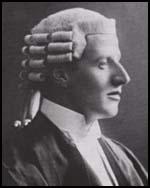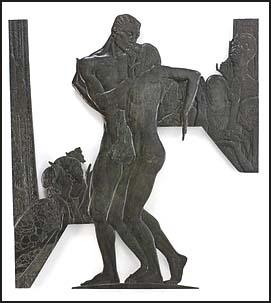Gilbert Cannan

Gilbert Cannan was born on 25th June 1884 at 24 Great Cheetham Street West, in Broughton. One of nine children, he was the second son of Henry Angus Cannan, a Scottish shipping clerk, and Violet Wright.
Cannan attended Ducie Avenue board school from where he won a foundation scholarship to Manchester Grammar School in 1898. A talented linguist, he won an open modern languages exhibition to King's College in 1902.
According to his biographer, Diane Farr, the author of Gilbert Cannan: A Georgian Prodigy (1978): "After university Cannan read for the bar, but later abandoned the law in order to write. He was tall and fair with an emperor's nose, and also quickly gained a foothold in literary and theatrical circles." He became obsessed with Kathleen Bruce, but she rejected Cannan and married Robert Falcon Scott, the explorer.
While working for the Society for the Abolition of Censorship he became involved with Mary Barrie (1868-1950), the wife of James Barrie, the author of Peter Pan (1904). In 1909 he was cited as the co-respondent in the divorce which ensued and, against the advice of H. G. Wells he married her out of a sense of chivalry on 28th April 1910.
The couple moved to a converted windmill in Cholesbury, Buckinghamshire. His friend Edward Marsh, introduced Cannan to the artist Mark Gertler. The two men became close friends. Gretchen Gerzina has pointed out: "He (Gertler) went for long walks, and in the evenings Cannan played the piano for him and they drank together. All the time they talked, and Gertler found in his new friend an amazingly eager audience." They agreed that Roger Fry "had a watered-down view of art which was less vital than their own". Gertler told his girlfriend, Dora Carrington, that he "liked Gilbert Cannan so much that I could scarcely tear myself away... we are already great friends." Soon afterwards, Carrington became a regular visitor to Cannan's house.
Gilbert Cannan and his wife entertained writers and artists, including Mark Gertler, Dora Carrington, Ottoline Morrell, D. H. Lawrence, Frieda Lawrence, Duncan Grant, Dorothy Brett, John Middleton Murray, Katherine Mansfield, Edward Marsh, David Garnett and Compton Mackenzie.
Cannan's first novel, Peter Homunculus was published in 1909. This was followed by Devious Ways (1910), Little Brother (1912) and Round The Corner (1913). Later that year Henry James described Cannan, along with D. H. Lawrence, Compton Mackenzie, and Hugh Walpole, as the four up-and-coming authors. He also worked as a theatre critic and and also wrote reviews and plays.
In 1916 Cannan published the novel Mendel: A Story of Youth. It was based on the lives of his friends, Mark Gertler, Dora Carrington and John S. Currie. The novel tells the story of an impetuous but talented immigrant painter, Mendel Kuhler (Gertler) who is in love with Greta Morrison (Carrington), who refuses to sleep with him. D. H. Lawrence explained how "Gertler... has told every detail of his life to Gilbert... who has a lawyer's memory and he has put it all down, and so ridiculously when it comes to the love affair... it is a bad book - statement without creation - really journalism." Carrington was furious that Gertler had told Cannan about their relationship: "How angry I am over Gilbert's book. Everywhere this confounded gossip, and servant-like curiously. It's ugly and so damned vulgar."
Cannan was a pacifist and during the First World War he was a conscientious objector, and was involved in the National Council Against Conscription. During this period Cannan fell in love with the 19 year-old Gwen Wilson. He left his wife and set up home with her. On 11th April 1918, Mary Cannan was granted a judicial separation from her husband.

Cannan and Wilson rented a studio in St John's Wood. They took a lodger, Henry Mond, this arrangement subsequently resulted in a ménage à trois. They commissioned Charles Sargeant Jagger to produce a relief called Scandal, which they displayed in their living room. This showed a naked couple in an intimate embrace watched by a group of gossiping people. In 1920, while Cannan was lecturing in the United States, Mond married Gwen. This triggered a deep depression and in April 1924 he was certified insane and became a patient in The Priory in Roehampton.
Gilbert Cannan died of cancer on 30th June 1955 at Holloway Sanatorium in Virginia Water.
Primary Sources
(1) Gretchen Gerzina, A Life of Dora Carrington: 1893-1932 (1989)
While Carrington was hard at work, Gertler was becoming even closer to Cannan. "He is a true man," he wrote in April. "There are not many like him. I like him truly. In the evenings we sit in the dimly lit mill, where he plays Beethoven to me and then we talk and talk." It was inevitable that Cannan, hearing so much about Gertler's life, would want to meet Carrington, and during 1914 she began to join Gertler on his weekend visits to Cholesbury.
Gertler also told Cannan about his artist friend John Currie, who was the cause of a major tragedy in October of that year. His lover, Dolly Henry (whose real name was O'Henry), had moved away from him and found rooms of her own in Paulton Square, Chelsea. Currie went there one evening and they had a terrible argument, in which he shot her and then turned the gun on himself. She died immediately, and he died later in the Chelsea Infirmary, under police guard. Gertler visited him in the Infirmary shortly before he died, and the whole sordid affair deeply affected him. Currie, seven years older than Gertler, had been a mentor to him. He had had little respect for private property, and used to help himself to whatever he desired, even though it might be in a friend's home. He had read Nietzsche earnestly, and had had great self-confidence. He had lived openly with Dolly, and the two of them had taken Gertler to Paris with them, initiating him into great art, petty lovers' quarrels, and foreign culture, all at first hand. As he had done with everything Gertler had told him, Cannan had made careful note of these events and had romanticised them in his fiction.
In need of a confidant, Gertler had long ago turned to Gilbert Cannan. In a situation reminiscent of that with Nevinson, Mark became enraged by an innocent kiss between the two friends, although he spent many, perhaps most, of his happiest hours at Cannan's mill house in Cholesbury, frequently with Carrington. On his visits there alone, he unburdened himself to his friend. In May 1916 he wrote proudly and rather ingenuously to Strachey that "Gilbert is not writing, but has written a book (it took two months) about a young man who, I believe, is supposed to resemble me, but I don't know." This book, Mendel, would appear within a few months.
